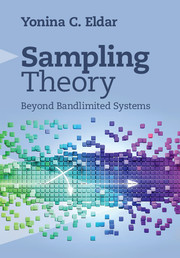Book contents
- Frontmatter
- Dedication
- Contents
- Preface
- 1 Introduction
- 2 Introduction to linear algebra
- 3 Fourier analysis
- 4 Signal spaces
- 5 Shift-invariant spaces
- 6 Subspace priors
- 7 Smoothness priors
- 8 Nonlinear sampling
- 9 Resampling
- 10 Union of subspaces
- 11 Compressed sensing
- 12 Sampling over finite unions
- 13 Sampling over shift-invariant unions
- 14 Multiband sampling
- 15 Finite rate of innovation sampling
- Appendix A Finite linear algebra
- Appendix B Stochastic signals
- References
- Index
3 - Fourier analysis
Published online by Cambridge University Press: 05 August 2014
- Frontmatter
- Dedication
- Contents
- Preface
- 1 Introduction
- 2 Introduction to linear algebra
- 3 Fourier analysis
- 4 Signal spaces
- 5 Shift-invariant spaces
- 6 Subspace priors
- 7 Smoothness priors
- 8 Nonlinear sampling
- 9 Resampling
- 10 Union of subspaces
- 11 Compressed sensing
- 12 Sampling over finite unions
- 13 Sampling over shift-invariant unions
- 14 Multiband sampling
- 15 Finite rate of innovation sampling
- Appendix A Finite linear algebra
- Appendix B Stochastic signals
- References
- Index
Summary
In the previous chapter we considered expansions of signals in appropriate bases, which can be interpreted as sampling and reconstruction. However, the expansions we discussed were written in abstract form so that it is not immediately obvious how to translate them to concrete sampling methods and practical reconstruction algorithms. From an engineering perspective, our interest is in sampling theories that can be implemented in practice using standard analog components such as filters and modulators. In the next chapter we move away from the abstract formulation and concentrate on concrete signal classes for which the representations we are interested in can be implemented efficiently using common engineering building blocks. The advantage of these settings is that much of the analysis can be carried out efficiently and in a simple manner in the Fourier domain. Therefore, a large part of the tools and methods used in the rest of the book for developing sampling theorems will rely on Fourier analysis.
In this chapter we provide a self-contained presentation of the results needed in the context of linear time-invariant systems and Fourier representations. We review both the continuous-time and discrete-time Fourier representations, and discuss the relationship between the two in the context of sampled signals. There are many excellent textbooks on Fourier analysis; our goal here is to summarize the properties needed in our derivations and the key relations we exploit between continuous-time and discrete-time transforms.
- Type
- Chapter
- Information
- Sampling TheoryBeyond Bandlimited Systems, pp. 67 - 93Publisher: Cambridge University PressPrint publication year: 2015

